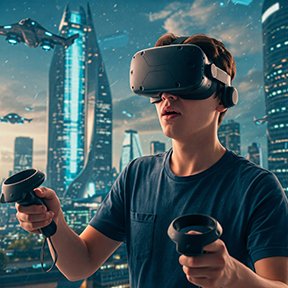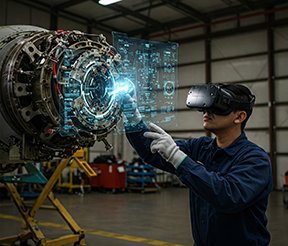Published: August 23, 2016 | Updated: September 30, 2025
Published: August 23, 2016 | Updated: September 30, 2025
The Immersive Future of Maintenance: VR's Impact on CMMS
 The convergence of cutting-edge technologies often sparks transformative shifts across industries. One such promising intersection involves virtual reality (VR) and computerized maintenance management systems (CMMS). While VR once resided primarily in the realm of gaming and entertainment, its potential applications now extend into critical sectors like industrial maintenance. This exploration delves into the immersive future of maintenance and VR's Impact on CMMS.
The convergence of cutting-edge technologies often sparks transformative shifts across industries. One such promising intersection involves virtual reality (VR) and computerized maintenance management systems (CMMS). While VR once resided primarily in the realm of gaming and entertainment, its potential applications now extend into critical sectors like industrial maintenance. This exploration delves into the immersive future of maintenance and VR's Impact on CMMS.
The Natural Alignment of VR and Reliability
Surprisingly, the principles of virtual reality and the demands of the reliability industry demonstrate a strong inherent compatibility. VR excels at creating immersive, interactive environments that simulate real-world scenarios. This capability directly addresses several key challenges within maintenance and reliability, such as the complexities of equipment training, the difficulties of remote troubleshooting, and the need for accessible and comprehensive documentation. The ability of VR to transport users to virtual representations of physical assets opens up entirely new avenues for how maintenance professionals learn, collaborate, and execute their tasks.
Immersive Training Environments
Consider the impact of VR on industrial education. Traditional training methods often involve static manuals, classroom lectures, or on-the-job learning, which can present limitations in terms of engagement, safety, and cost-effectiveness. VR offers a compelling alternative by providing interactive training simulations. Imagine a technician donning a VR headset and entering a virtual replica of a complex machine. Within this simulated environment, they can practice intricate maintenance procedures, disassemble and reassemble components, and troubleshoot potential issues without the risk of damaging actual equipment or causing downtime. This hands-on, experiential learning accelerates comprehension and skill development in a safe and controlled setting. VR training modules can also adapt to individual learning paces and provide immediate feedback, enhancing the overall learning experience.
Cost and Time Savings in Training
The economic advantages of VR-based training are also significant. Organizations can reduce the costs associated with travel, physical training equipment, and potential damage during learning. New employees can gain proficiency in specialized machinery located in distant facilities without ever leaving the training room. This capability proves particularly valuable for companies with geographically dispersed operations.
The time investment in training also sees potential reduction, as immersive simulations often lead to faster knowledge acquisition and retention compared to traditional methods. Technicians gain practical experience in a compressed timeframe, allowing them to become productive members of the maintenance team more quickly.
Discover how streamlined maintenance processes can elevate production. Learn more.
Remote Expertise and Assistance Through VR
Equipment breakdowns can occur unexpectedly, often requiring specialized knowledge for diagnosis and repair. When on-site expertise is unavailable, delays and significant downtime can ensue. VR offers a powerful solution for remote assistance. Imagine a field technician encountering a complex issue. Through a VR interface, a remote expert can virtually step into the technician's environment, view the equipment in real-time, and provide step-by-step guidance. The expert can annotate the technician's view, highlight specific components, and even demonstrate repair procedures virtually. This capability minimizes travel costs and downtime, allowing for quicker resolution of maintenance issues and maximizing asset availability. The ability to collaborate remotely in an immersive virtual space transforms how support and expertise get delivered.
Revolutionizing Documentation and Information Access
Navigating through dense technical manuals and schematics can be a time-consuming and often frustrating task for maintenance personnel. VR presents an innovative approach to document management within a CMMS. Instead of sifting through paper documents or scrolling through digital files, technicians can access information within a virtual environment.
Imagine entering a virtual data room where maintenance manuals, equipment diagrams, and repair histories appear as interactive 3D objects. Users can manipulate these virtual documents, zoom in on intricate details, and even view animated sequences illustrating complex procedures. This immersive access to information enhances comprehension and reduces the time spent searching for critical data, ultimately improving the efficiency of maintenance tasks.
Interactive Digital Twins for Enhanced Understanding
Taking the concept of virtual documentation a step further leads to the integration of digital twins within a VR-enabled CMMS. A digital twin represents a virtual counterpart of a physical asset, complete with real-time data and performance metrics. Through a VR interface, maintenance personnel can interact with a digital twin to gain a deeper understanding of the asset's condition, identify potential issues, and plan maintenance activities proactively. They can visualize historical data, simulate different scenarios, and even predict future performance, all within an immersive virtual representation of the physical equipment. This level of insight empowers more informed decision-making and contributes to a more predictive maintenance strategy.
Unlocking Industry Potential: VR and CMMS in Action
The synergistic relationship between virtual reality (VR) and computerized maintenance management systems (CMMS) holds immense potential to transform maintenance practices across a multitude of sectors. By merging immersive visual experiences with intelligent data management, this powerful combination addresses unique industry challenges and unlocks significant advantages. The following outlines four key industries poised to experience substantial benefits from the integration of VR and CMMS.
Key Industries Benefiting from VR and CMMS Integration
- Manufacturing: Precision and Proactive Maintenance—The manufacturing sector relies heavily on consistent production and minimal disruptions. VR enhances CMMS capabilities by providing immersive training simulations for operating and maintaining complex machinery. Technicians gain hands-on virtual experience with intricate procedures and troubleshooting, reducing errors and potential equipment damage during real-world interventions. Furthermore, integrating digital twins within a VR-CMMS allows for real-time visualization of asset performance data, facilitating proactive maintenance planning and minimizing unexpected downtime. Remote VR-assisted guidance enables experts to support on-site technicians, accelerating repairs and improving overall equipment effectiveness.
- Healthcare: Ensuring Uptime and Accuracy of Critical Equipment—In healthcare, the continuous operation of medical equipment directly affects patient well-being. VR-CMMS integration offers significant advantages in this critical field. VR training modules allow biomedical technicians to practice maintenance and repair on sophisticated devices without disrupting patient care or risking damage. Immersive, step-by-step VR guides accessible through portable headsets at the equipment location ensure adherence to correct maintenance protocols. Remote experts can provide real-time visual assistance via VR for complex repairs, ensuring quicker resolution of equipment malfunctions and maximizing the availability of essential medical devices.
- Oil and Gas: Safety and Efficiency in Hazardous Environments—The oil and gas industry often involves hazardous and remote operational settings, making maintenance and training particularly demanding. VR, combined with a CMMS, significantly improves safety and efficiency. VR simulations immerse personnel in realistic scenarios for emergency response and equipment maintenance in hazardous environments, enhancing preparedness and reducing risks. A VR-integrated CMMS provides virtual access to equipment documentation and 3D models at the worksite. Remote experts can guide field technicians through complex procedures using augmented reality overlays within the VR environment, minimizing travel and accelerating issue resolution in these challenging locations.
 Aviation: Precision Maintenance for Safety-Critical Assets—Safety remains paramount in the aviation industry, demanding meticulous aircraft maintenance. VR-CMMS integration offers powerful tools for training and maintenance operations. VR simulations provide immersive, hands-on training for complex maintenance tasks, enhancing technician proficiency and reducing the potential for errors. Access to detailed 3D models and maintenance procedures through VR headsets provides immediate visual guidance during inspections and repairs. Remote VR collaboration connects on-site technicians with experienced engineers for real-time support, minimizing aircraft downtime and ensuring adherence to stringent safety regulations.
Aviation: Precision Maintenance for Safety-Critical Assets—Safety remains paramount in the aviation industry, demanding meticulous aircraft maintenance. VR-CMMS integration offers powerful tools for training and maintenance operations. VR simulations provide immersive, hands-on training for complex maintenance tasks, enhancing technician proficiency and reducing the potential for errors. Access to detailed 3D models and maintenance procedures through VR headsets provides immediate visual guidance during inspections and repairs. Remote VR collaboration connects on-site technicians with experienced engineers for real-time support, minimizing aircraft downtime and ensuring adherence to stringent safety regulations.
The integration of virtual reality with computerized maintenance management systems represents a significant step forward for these and other industries. By leveraging the power of immersive experiences and intelligent data management, organizations can cultivate a more skilled workforce, enhance the efficiency of maintenance operations, and ultimately achieve greater asset reliability and safety across their critical infrastructure.
Expanding the Horizons: Beyond Training and Support
The potential of VR integration extends beyond training and remote assistance. Consider virtual workshops and conferences where maintenance professionals from around the globe can connect and collaborate in a shared virtual space. Imagine attending a virtual trade show to explore new technologies and interact with vendors as if physically present. Furthermore, VR can facilitate live customer support, allowing users to receive visual guidance and troubleshooting assistance directly within a virtual representation of their equipment. Even virtual stores for spare parts become a possibility, enabling technicians to visually inspect and select components in an immersive digital environment. These applications illustrate the broad transformative potential of VR within the maintenance and reliability landscape.
The fusion of virtual reality and computerized maintenance management systems marks an exciting evolution in the reliability industry. While the aesthetic appeal of VR headsets continues to evolve, the practical benefits for maintenance operations become increasingly clear. This convergence promises to reshape how organizations approach training, support, documentation, and overall asset management, ushering in a new era of immersive and interactive maintenance practices.
FAQs
What is a CMMS and how does VR improve it?
A CMMS is a computerized maintenance management system, and VR enhances it with immersive training, real-time remote support, and interactive digital twins.
How does VR training benefit maintenance teams?
VR training provides safe, hands-on practice with complex equipment, reducing errors and speeding up skill development.
Can CMMS software like MAPCON integrate with VR?
Yes, MAPCON CMMS can integrate with VR, but clients will need assistance from MAPCON support to ensure proper setup and implementation.
What industries benefit most from VR and CMMS integration?
Manufacturing, healthcare, aviation, and oil & gas all gain from safer, faster, and more accurate maintenance practices.
Does VR reduce downtime in maintenance operations?
Yes, VR enables faster training, remote expert assistance, and predictive planning, which minimize downtime.
Why choose MAPCON CMMS for VR-enabled maintenance?
MAPCON CMMS offers flexibility, scalability, and VR compatibility, making it a strong choice for organizations adopting immersive maintenance technology.
MAPCON | 800-922-4336
MAPCON CMMS software empowers you to plan and execute PM tasks flawlessly, thanks to its wealth of features and customizable options. Want to see it for yourself? Click the button below to get your FREE 30-day trial of MAPCON!
Try It FREE!